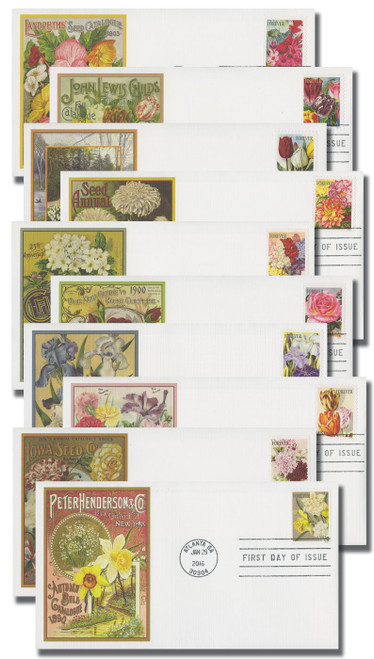
2016 First-Class Forever Stamp,Imperforate Botanical Art
# 5042-51d - 2016 First-Class Forever Stamp - Imperforate Botanical Art
$295.00
U.S. #5042-51d
2016 49¢ Imperforate Botanical Art
First-Class Mail Forever
Today, about 1,800 botanical gardens exist across the globe. These can range from small specialty gardens to sprawling campuses that contain thousands of plants.
Botanical art has complemented gardening catalogs and magazines for over two centuries. In 1784, David Landreth established the first mail order seed catalog. His reputation grew and soon Landreth’s customers included George Washington and Thomas Jefferson.
Landreth introduced the zinnia to the United States in 1798, followed by the first truly white potato, and then the tomato. In 1832, he unveiled the nation’s first floral and horticultural magazine. Following Landreth’s success, the 19th century saw an explosion of seed companies and catalogs.
The Industrial Age ushered in items of convenience and created more leisure time for many Americans. Elaborate flower gardens came in trend, and seed catalog covers were the best place to showcase new varieties. The W. Atlee Burpee Company was especially skilled in promoting new and improved seed varieties each year. Beautifully executed cover art created desire for these new varieties, and sales soared. Other companies soon followed suit and many still prefer using cover art over photography today.
Value: First-Class Mail Rate
Issued: January 29, 2016
First Day City: Atlanta, GA
Type of Stamp: Definitive (Imperforate)
Printed by: Ashton Potter
Method: Offset printing in booklet of 10 OR double-sided booklet of 20
Self-Adhesive
Quantity Printed: 56,000
The 2016 49¢ Botanical Art stamps feature 10 new designs based on illustrations from an American nursery catalog. These catalogs were published between 1891 and 1912 and are part of the New York Botanical Garden’s Seed Catalog Collection – one of the largest and important collections in the U.S.
These colorful issues feature eight types of flowers: Corn lilies, tulips, dahlias, stocks, roses, Japanese irises, petunias, daffodils, and jonquils.
U.S. #5042-51d
2016 49¢ Imperforate Botanical Art
First-Class Mail Forever
Today, about 1,800 botanical gardens exist across the globe. These can range from small specialty gardens to sprawling campuses that contain thousands of plants.
Botanical art has complemented gardening catalogs and magazines for over two centuries. In 1784, David Landreth established the first mail order seed catalog. His reputation grew and soon Landreth’s customers included George Washington and Thomas Jefferson.
Landreth introduced the zinnia to the United States in 1798, followed by the first truly white potato, and then the tomato. In 1832, he unveiled the nation’s first floral and horticultural magazine. Following Landreth’s success, the 19th century saw an explosion of seed companies and catalogs.
The Industrial Age ushered in items of convenience and created more leisure time for many Americans. Elaborate flower gardens came in trend, and seed catalog covers were the best place to showcase new varieties. The W. Atlee Burpee Company was especially skilled in promoting new and improved seed varieties each year. Beautifully executed cover art created desire for these new varieties, and sales soared. Other companies soon followed suit and many still prefer using cover art over photography today.
Value: First-Class Mail Rate
Issued: January 29, 2016
First Day City: Atlanta, GA
Type of Stamp: Definitive (Imperforate)
Printed by: Ashton Potter
Method: Offset printing in booklet of 10 OR double-sided booklet of 20
Self-Adhesive
Quantity Printed: 56,000
The 2016 49¢ Botanical Art stamps feature 10 new designs based on illustrations from an American nursery catalog. These catalogs were published between 1891 and 1912 and are part of the New York Botanical Garden’s Seed Catalog Collection – one of the largest and important collections in the U.S.
These colorful issues feature eight types of flowers: Corn lilies, tulips, dahlias, stocks, roses, Japanese irises, petunias, daffodils, and jonquils.







